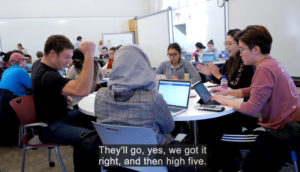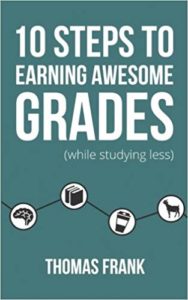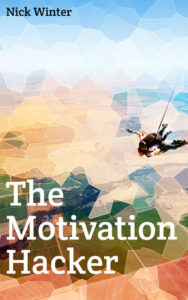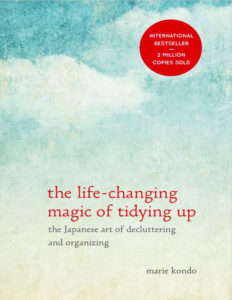BOOKS
On this page, I want to recommend books that I come across. There are and there won’t be a lot here. This is because I feel it is a great reponsibility to recommend a book, as the person who you recommend the book to may actually read it. And if he/she hates it, you are responsible for wasting hours of his/her life (which will never come back).
This is why my list is very short.
15 December 2020:
Sheila Tobias: They’re not dumb, they’re different
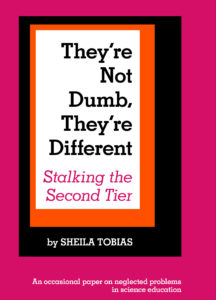
This book deals with a very important question, which is why many science students loose interest in their study subject during their time in University. And as the author reveals. a lot has to do with the way science is taught in University. Although the book was written 30 years ago, I could discover a lot of insights that really resonate.
Sheila Tobias divides Science majors into a first tier and a second tier. The first tier are the students who are firmly set to become scientists and who will stick to science no matter how bad the teaching is. The second tier are the students who initially are inclined towards science, but then loose interest as a result of how science is being taught. Losing the second tear is a loss indeed, because these students often have wide-ranging interests. They could hence bring different perspectives into science, which is nowadays well-recognized to be critical for innovation and scientific progress.
Why are many students turned off by the way science is taught? The author investigated this question by asking graduate students from the field of Arts and Social Sciences to take first year Science undergraduate modules. These students had a very different view point, having gone through non-science related undergraduate studies that provided a very different experience for them. Although almost all of the students did very well in the undergraduate science modules, they generally did not enjoy the introductory science courses. Importantly, they provided some very useful insights.
The biggest problem for the students seemed to be that the introductory physics and chemistry science courses in which they enrolled mainly taught and practiced solving problems. Acquiring problem solving skills is important, and it also keeps students alert and motivated. But what became clear to me in the book is that solving problems by itself does not get students interested in a topic. The stand-in students felt that the problems were not interesting because they had all been solved before. Furthermore, what the lectures taught them was essentially “Right-answer science”, where the problem had only one correct answer, which the students had to find. As the author states, this is a “is a pedagogical turnoff”. The stand-in students were missing conceptual problems, where they needed to find and create solutions on their own and not just plug in variables. The students also wanted to be able to question and discuss concepts.
The assessments also mirrored these teaching approaches. The exams tested for memorized knowledge and the ability to use the taught algorithms. But they did not provide conceptual challenges and often did not test real understanding. This meant that students could do reasonably well in a course without really having gained much deep understanding.
Based on my own impressions, not much has changed over the past 30 years in science education. As the comments of some of the instructors who taught the modules suggest, one reason for this may be that science lecturers take for granted that the students are already committed to become scientists. They see their responsibility in equipping students with the knowledge and tools to understand scientific concepts. Instead, it would be good if they would try to win over more students, and in doing so, remember how they themselves became interested in science.
What I realized is that when I teach students in my Cell Biology course about experimental tools and data interpretation skills, these skills must only be a tool to answer “why” and “how” questions and not the purpose or objective itself. In other words, there should be problems that we discuss based on these skills and these problems should be relevant, interesting and not have known answers. Indeed, one of the stand-in students felt that what was missing in lectures was an opportunity to “speculate beyond the simple chemical properties to the implications of the experiment itself.” This also means to give individual students more attention in order to make them realize that their opinions count.
When taking the in the introductory science courses, the stand-in students felt that science is very certain and lacks creativity. But this is in fact not true at all. However, unfortunately, as the authors states, only “students who stay long enough in science to take higher-level courses begin to see science as more creative, less certain.” But all to often before students would reach this stage, they have already been put off from being passionate about science or from pursuing it.
This means that science lecturers really need to make an effort early on to keep students’ interest levels high. This can be achieved by letting the students come up with their own questions and solutions, by discussing more relevant and thought-provoking concepts and by challenging students’ critical and creative thinking abilities. Students should become aware that scientific discovery and knowledge gain is an ongoing process and that many, if not most, important scientific problems have not yet been solved.
Another problem is that some of the students felt that they were merely touching the surface of the subjects and that they would never really master it. If students feel that they cannot master a course, this robs them of their motivation. As such, I think it is important to make the students aware of how the taught content fits into the bigger picture and what the current state of knowledge is.
Adding to the students’ sense that they can never truly master the content, the book also highlights that many science undergraduates feel intimidated by the perceived competence of their peers. They feel intimidated by how good “everyone” else is, and how hard “everyone” else works. This is partly brought about by the focus on individual learning and assessment and the lack of of collaboration and cooperation between students.
Which brings us to the final, and possibly most important shortcoming in Science undergraduate education – immense competition. In science courses, students generally work individually. The stand-in students found a complete absence of a learning community. Their impression was that students’ major focus in science courses is not on learning, but on doing well. And due to the competitive environment, doing well becomes an end goal in itself.
The absence of a learning community and competitiveness are partly due to the commonly large class sizes as well as the frequent grading of students on a bell curve. But no matter what the reasons are, lack of a learning community and competition are major factors that get students lose interest in science. This is why it is important to promote collaboration through group work, include non-graded components (one can assign participation marks) and find other ways to get students excited by coming up with creative questions and solutions that are neither right or wrong. It is not an easy undertaking, but seeing students excited about what they are learning in the classroom is a very satisfactory experience, indeed.
In fact, to promote student collaboration and get students more excited, I will be using Peer Instruction via Learning Catalytics in my undergraduate module next semester, which I myself am also very excited about. Here is a preview of how it works.
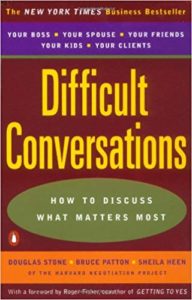 Stone, Patton, Heen: Difficult Conversations
Stone, Patton, Heen: Difficult Conversations
This was a real eye-opener for me, revealing concepts about conversations and conflicts that had never occurred to me. And I realised from this book why other people act in often inexplicable ways. I think conflict with others is common to everyone’s life, whether it is conflict with friends, parents, lab colleagues etc. The solutions offered in this book require conscious effort and time to apply successfully. But it is definitely worth this effort.
FOR SPECIALISED AUDIENCES:
Thomas Frank: 10 Steps to Earning Awsome Grades
This book is about how to get good grades, without studying more (or studying less). Thomas Frank has a lot of great suggestions. And he is a great writer, too. Please see his website and blog at collegeinfogeek.com, where you can sign up and get the book for free.
Marie Kondo: The life-changing magic of tidying up
The book did indeed do magic for me! Truly life-changing. And a very fun read, too!
